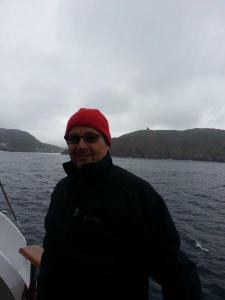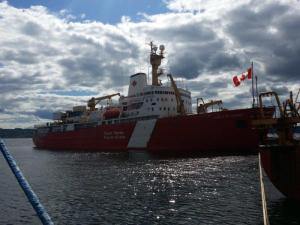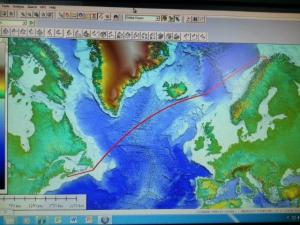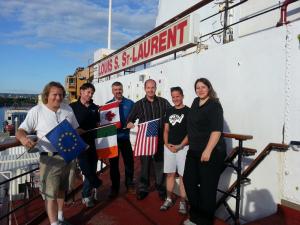By Edward Owens

Hello to all from the Canadian Coast Guard vessel Louis S. St-Laurent (CCG LSSL), affectionately called the ‘Louis.’ She is an impressive 120 m long, 24.5 m wide with a cruising range of 23,000 nautical miles and carries two CCG helicopters. There are 86 cabins with 100 bunks and today she currently sails with 77 souls on board. I’ve gotten lost, turned around, and confused while navigating my way through the labyrinth of neat and tidy stairways, corridors, and doorways on numerous occasions. Luckily, I’m beginning to find my way around thanks to all the artwork and placards mounted on the walls which I’ve depended on as landmarks to help me get where I’m going. Everything is arranged on five main decks. I am berthed on the 300 level or the flight and boat deck conveniently near the acoustics science lab. The galley is three decks down and as long as I can find it, I’ll be just grand.
Today is Monday, the 27 of July, and it is 08:40 UTC (ship’s time), 06:10 St. John’s time (we are just off the Newfoundland coast), and 05:40 along the U.S. East Coast. Sunday afternoon we made a short stop at The Narrows, the entrance to Newfoundland’s city of St. John’s. There was a slight wind and low sky with temperatures in the refreshing low 50°’s F. The fast boat was deployed to make a few runs to the harbor to collect additional personnel waiting to join the ship along with many parcels and packages that made their way on board before we set off on the main leg of our journey. As a good omen, numerous species of whales fed, frolicked, and spouted into the cool air about the ship bidding us on our way.
We had left Halifax, Nova Scotia, on Friday from Canada’s impressive Bedford Institute of Oceanography, which sits nestled in the Bedford basin at the rear of Halifax harbor. Outside, the Coast Guard maintains a number of multi-purpose research vessels. I have been invited aboard on the first leg (Halifax – Tromsø, Norway) of a four-month Arctic voyage as part of an international scientific collaboration between Europe, Canada, and the U.S. to begin the long and complex task of mapping the seabed of the North Atlantic Ocean. The survey is the second to be launched by the alliance, formed in May 2013, following the Galway Statement on Atlantic Ocean Cooperation (named such for the location of the documents signing in Ireland). The three signatories agreed to jointly undertake the challenge to better understand the North Atlantic Ocean, and to promote the sustainable management of its resources.

The first survey under these auspices was led by the INFOMAR team (integrated mapping for the sustainable development of Ireland’s marine resource) on the R. V. Celtic Explorer who were joined by representatives of each of the signatories of the Galway Statement: the Marine Institute (Canada), the National Oceanic and Atmospheric Administration (U.S.), and Portuguese Sea and Atmosphere Institute (Portugal) and Marine Institute (Ireland) representing the European Union. The international team transited from St. John’s, Newfoundland to Galway in June 2015.
The second survey is hosted in July by the Canadian Government aboard the Louis as we transit from Halifax to Tromsø in Norway. The team is led by Paola Travaglini of the Canadian Hydrographic Service (CHS) with Shauna Neary (CHS), Dave Levy (CHS), Kirk Regular (Fisheries and Marine Institute of Memorial University, Newfoundland), David O’Sullivan (Ireland’s Marine Institute and INFOMAR), and myself, Edward Owens, representing NOAA. The team is highly experienced and extremely enthusiastic about the mission at hand and the chance to collaborate with their international colleagues; speaking for myself, it’s an opportunity that is not only exciting but the outcomes are hugely beneficial to build relations, learn, and succeed with our partners as we cooperate in this effort. After the survey mission to Tromsø is complete (hopefully on August 4) the Louis will continue into the high Arctic after the international team departs and will re-enter Canadian waters in November via the Northwest Passage after sailing to the North Pole. Incidentally, the Louis was one of two surface vessels that were the first to cross the Arctic Ocean via the geographical North Pole in 1994. I find after a taste of the open ocean, the prospect of making another of these crossings tempts me as we are heading into the deep water for this transit north.

The journey until now has been relatively uneventful as the team orientates itself and begins to acclimate to a daily survey routine. As we make our way off the Nova Scotian shelf, where ocean depths are not much greater than 200 meters deep, the sonar depths decline gradually down the Orphan Knoll Slump and into thousands of meters of ocean water. We are operating an EM122 multibeam echo sounder which sends and receives acoustic signals to/from the seabed giving accurate depth readings and also an indication of seafloor type. Additionally, we are logging sub-bottom and mid-water bathymetry data to take full advantage of this crossing and provide data to a larger audience in the scientific and commercial community. The EM122 is a deep-water echo sounder and will really come into its own in deeper waters off the edge of the shelf and return detailed, high-resolution imagery of the seabed. Here we expect to chart the deep ocean waters of the Atlantic Basin and up and over the Mid-Atlantic Ridge.
During the cruise I intend to describe life aboard a Canadian Coast Guard vessel and share the thoughts of the officers and the crew of the Louis as it crosses into the Arctic Circle. There is a strong community spirit already evident. A ship’s announcement has just said there is a ‘ceremony’ later for those who have never crossed into the Arctic Circle before…stories of reverse Mohawk haircuts and the like abound. There are nine new CCG cadets on board, so hopefully they’ll attract the most attention, but for once I’m quite content to be in the left lane on the freeway to baldness already! I’ll try and report on what could be dangerously interpreted as a kind of initiation of sorts…
…farewell from the Louis for now…


One Reply to “Coast Survey participates in international Arctic survey project”